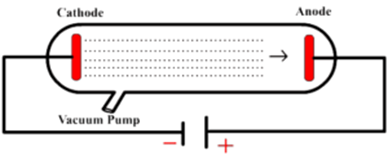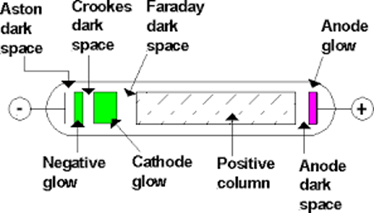Science > Physics > Cathode Rays and X- Rays > Cathode Rays
In 1859, Julius Plucker started the study of the conduction of electricity through gases at low pressure in the discharge tube. William Crooke, J. Perrin, J. J. Thomson did a further investigation in this field. In 1885, Sir William Crookes carried out several experiments to study the behaviour of heated metal in a vacuum. He found that cathode produces a stream of radiation, which could cause a glow in gases at low pressure. He called these radiations coming out of the cathode as cathode rays. Then he studied the behaviour in the discharge tube. At atmospheric pressure or at a higher pressure no electric current flows through the tube because gases are a poor conductor of electricity.
Discharge Tube:

The Discharge tube is a glass tube used to study the flow of electricity through gases at low pressures. The discharge tube consists of a thick-walled glass tube about 40 to 50 cm in length and about 3 to 4 cm in diameter. The tube is closed at both ends and has a side tube connected to a vacuum pump and a pressure gauge. Electrodes are disc-shaped made up of aluminium are sealed in the tube at two ends. A high D.C. voltage of 10,000 to 15,000 volts can be applied between the electrodes. The tube is filled with air or any other gas in which the electric discharge at different low pressures is to be studied.
As the vacuum pump is operated the pressure of the gas in the discharge tube is gradually reduced and the discharge goes through different stages. The pressure can be read from the pressure gauge and can be made constant. This study of the discharge can be done at different pressures. If discharge tube is highly evacuated so that the pressure in the tube is of the order of 0.01 mm of mercury, certain rays are emitted by the cathode in the form of bluish streamers. These rays are called cathode rays.
Various Stages of the Discharge:

When the pressure of the gas is equal to the atmospheric pressure the resistance of the gas between the electrodes very high. Therefore, a very high voltage of the order of 50,000 V to 1,00,000 V is necessary to pass the discharge through the tube. This discharge is in the form of a series of white sparks travelling along an irregular path through the tube. The sparks are accompanied by a cracking noise.
When the pressure is reduced to about 10 mm of mercury and a potential difference of about 10,000 V is applied between the electrodes, the discharge occurs in the form of coloured streaks or streamers travelling from the cathode to the anode. If the discharge tube contains air the discharge is a pink colour.
When the pressure is reduced to about 5mm of mercury the discharge widens until it fills the entire tube. It is called the positive column. This type of discharge is called Geissler discharge.
When the pressure decreases to about 3 mm of mercury the positive column gets detached from the cathode where a bluish glow called the negative glow is seen. The space between the positive column and the negative glow is dark and is called Faraday’s dark space.

When the pressure drops to 1 mm of mercury the negative glow gets separated from the cathode glow. A dark space appears between the cathode glow and negative glow. It is called Crooke’s dark space. The positive column gets reduced in size and dark space increases in size.
As the pressure is reduced to about 0.05mm of mercury the negative glow shift towards the anode both Crooke’s dark space and Faraday’s dark space increases in size and the positive column is divided into a number of luminous discs separated from each other by dark spaces. These discs are called striation.
As the pressure is reduced further the positive column goes on decreasing in size and it finally disappears the negative column moves toward the right and grows with fainter and Crooke’s dark space increases in size. When the pressure is 0.01mm of mercury, Crooke’s dark space fills the entire tube. At this stage, the walls glow with a greenish fluorescence. This is due to the impact of some invisible rays emitted from the cathode. These rays are called cathode rays.
If the pressure is reduced stills further the tube becomes non-conducting.
Characteristics of Cathode Rays:
- The cathode rays are emitted normally from the surface of the cathode irrespective of the position of the anode.
- They travel at a speed of about 107 to 109 m/s.
- They travel in straight lines and cast sharp shadows of objects in their paths.

- They are able to produce fluorescence and phosphorescence in many substances when they fall on them. The colour of fluorescence depends upon the nature of substance e.g. Willemite emits green colour. Alumina emits red colours.
- They produce a blackening on a photographic plate when they are incident on it.
- On placing a light paddle wheel in the path of cathode rays in a discharge tube, the blades of paddle wheel rotate. It shows that cathode rays constitute particles.

- They consist of negatively charged particles.
- They generate heat when they strike a target.
- They are deflected by electric and magnetic fields and the direction of deflection shows that they are negatively charged particles.
- They can ionise the gases through which they pass
- They produce heat energy when they collide with the matter. It is due to the kinetic energy possessed by the cathode rays.
- They produce X – rays when stopped by a target.
- The nature of cathode rays does not depend on the nature of the gas and the material of the cathode used in the discharge tube.
Effect of Electric Field on Cathode Rays:
When an electric field is applied to the path of cathode rays, they are deflected towards the positive plate of the electric field. It shows that cathode rays are made up of negatively charged particles.

Effect of Magnetic Field on Cathode Rays:
When a magnetic field is applied to the path of cathode rays, they are deflected. It shows that cathode rays are made up of negatively charged particles.
Uses of Cathode Rays:
- Cathode rays tubes have been developed into C. R. O. (Cathode Ray Oscillators) which has wide application in electronics. They are also used as TV tubes.
- They are used to find the ratio of charge to mass (e/m) of the electrons.
- They are used to produce X – rays.
- They are used in electron microscopes which are used for a magnifying minute object to the extent that detail of the object can be studied.
Importance of Cathode rays in the Study of Atomic Structure:
They produce heat energy when they collide with the matter. It is due to the kinetic energy possessed by the cathode rays. Cathode rays also rotate the paddlewheel in their path. They move from the negative electrode to the positive electrode. Which clearly indicate that the cathode ray consists of a negatively charged particle. Thomson called these particles as negatrons. Stoney changed this name to electrons.